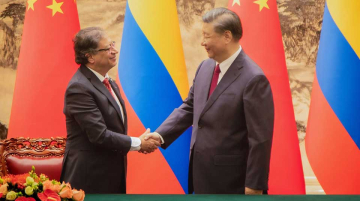
By Hugo Jones and Lukas Fiala
At this year’s G7 summit, a new acronym joined the ranks of competing development finance initiatives. Forget the B3W – the Partnership for Global Infrastructure and Investment (PGII) is the G7’s latest “joint offer to narrow the investment gap for sustainable, inclusive, climate-resilient, and quality infrastructure in emerging markets and developing countries”. It will raise “up to $600 billion” over the next five years, from both governments and private investors, and – you guessed it – is intended to compete directly with China’s Belt Road Initiative.
Despite many critical evaluations of the PGII over the past week, broadening policy spaces for developing countries by diversifying available sources of funding is certainly a good thing. The PGII also has a strong focus on sustainability, which aims at offering an alternative model to Chinese infrastructure financing that has burdened many countries in Africa and Asia with spiraling debt.
But can we even begin to compare the PGII to the BRI?
The power of the BRI was that it could be applied both retroactively and proactively – it created an umbrella narrative that tied together with the diverse reallocations of Chinese industrial overcapacity (many of which preceded Xi Jinping) into a compelling political, economic, historical, and cultural story.
If PGII is going to succeed, it will have to start with actions, not words alone. The BRI benefitted from building on a stack of activities that already existed before building new ones. It remains to be seen whether the PGII can follow suit.
AidData’s analysis of China’s development projects from 2000-2017 shows that the BRI was largely an extension of the “going out” strategy and did not change the sectoral or geographical composition of China’s development financing. In this way, the BRI provided a framework for an existing trend and funneled new money into it. In contrast, the PGII is attempting to fabricate a framework that seems at odds with macroeconomic trends. This is ambitious, to say the least.
Chinese media outlets were quick to raise the scale of these challenges. Firstly, the PGII needs governments and companies to raise capital at a time when interest rates are rising, and many economies appear to be entering recession. Secondly, financing hard infrastructure in an attempt to mirror the BRI neglects the fact that most Western economies are not really competitive in this area. The PGII should look to fill certain gaps where the U.S. and G7 countries have a proven history of success: international standards, cutting-edge research, capacity building, and education.
One example of how Western governments could support policymakers across the developing world in this regard is by building local capacity to negotiate with external actors – including Chinese and Western investors and creditors. For instance, by providing resources to local think tanks and policy institutes. But with realpolitik and ideology dominating the current debate on China across most Western capitals, and global capitalism benefitting from state fragility across the developing world, this is a far cry from becoming a reality anytime soon.
It is also important to note that, out of the seven leaders who gathered at the G7, at least three are facing existential crises of legitimacy in their respective countries, if not terminal decline. Enduring figureheads such as Angela Merkel are no longer there to present an image of consistency. We are likely to see a very different G7 lineup in five years’ time, potentially with more fiscally conservative governments, whereas we can be fairly certain that President Xi Jinping – and his signature foreign policy initiative – is going to be around in 2027.
Even if the trend of declining Chinese overseas investment continues, the BRI has an in-built advantage in that it is flexible. It will endure as both an initiative and as a slogan in some way, shape, or form. Contrary to popular opinion, the BRI is not a top-down operation carefully conducted by Beijing. Private companies, recipient governments, and local actors have utilized the BRI “brand” to fulfill their own interests and in doing so have shaped it. This high plasticity has been crucial to the BRI’s success.
And it may serve as a starting point for competing effectively with China’s clout in global development finance and providing a tangible alternative to Chinese money: creating a framework that is adaptive – vague enough to include a host of public, private, domestic, and geopolitical interests and incentives, but concrete enough so that it tells a compelling story of why the West still matters.
However, if any such initiative is to succeed, it will have to start with actions, not words alone. The BRI benefitted from building on a stack of activities that already existed before building new ones. It remains to be seen whether the PGII can follow suit. Otherwise, we should expect a fresh serving of alphabet soup from the G7 in another 12 months.
Lukas Fiala is the China Foresight Project Coordinator at LSE IDEAS and Hugo Jones is a program assistant at LSE IDEAS.








